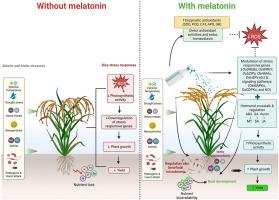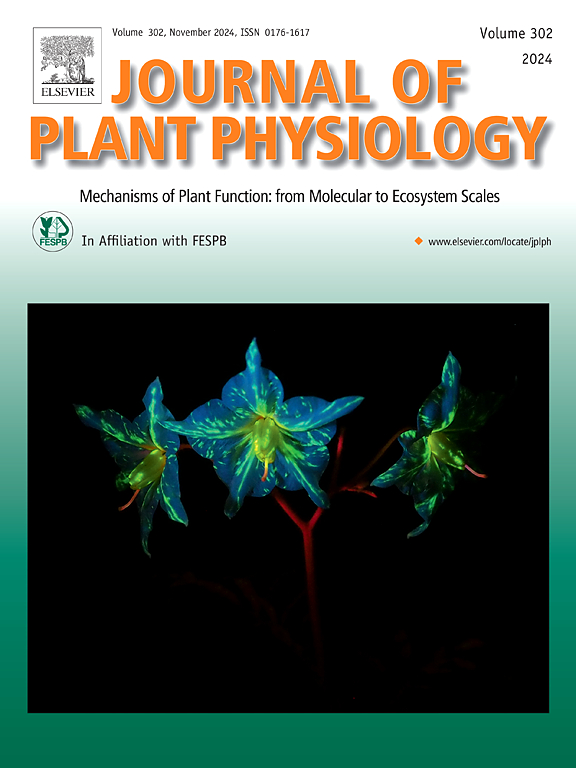Melatonin as a multifaceted stress protector in rice: Mechanisms, synergies, and knowledge gaps
IF 4.1
3区 生物学
Q1 PLANT SCIENCES
引用次数: 0
Abstract
Rice productivity, a cornerstone of global food security, is increasingly threatened by a spectrum of abiotic and biotic stressors, including heavy metal toxicity, salinity, drought, temperature extremes, flooding/water logging, nutrient deficiencies, and pathogens or pest infestations. Melatonin (N-acetyl-5-methoxytryptamine), also referred to as phytomelatonin, was first identified in plants in 1995 and has since emerged as a potent antioxidant and versatile signaling molecule. It plays a critical role in integrating hormonal networks and modulating stress responses in plants, including rice. Both endogenous and exogenously applied melatonin enhance rice tolerance to multiple stress conditions by improving photosynthetic efficiency, reinforcing antioxidant defense systems, maintaining ionic and osmotic homeostasis, and regulating growth and development processes. In the context of biotic stress, melatonin activates innate immune mechanisms, including modulation of defense genes, synthesis of phytoalexins, and fortification of structural barriers, thereby enhancing resistance to pathogens and insect herbivores. Notably, combinatorial applications of melatonin with silicon and nano-zero-valent iron have demonstrated synergistic effects, significantly augmenting stress resilience under complex environmental conditions. Despite these advancements, key knowledge gaps persist regarding mechanistic understanding of melatonin signaling, particularly its interaction with the OsPMTR1 receptor, as well as its efficacy under multi-stress field scenarios. Moreover, melatonin's functional outcomes are influenced by rice genotype and environmental context, underscoring the need for optimized application strategies (such as foliar spray, seed priming, and root drenching), and precise dosage calibration to maximize protective benefits while avoiding phytotoxic effects. This review synthesizes current insights into melatonin biosynthesis, signaling pathways, and its multifaceted roles in rice stress physiology, while identifying critical knowledge gaps and underscoring its potential as an integrative and sustainable strategy for advancing climate-resilient rice production.

褪黑素作为水稻的多方面应激保护:机制、协同作用和知识差距
水稻生产力作为全球粮食安全的基石,正日益受到一系列非生物和生物压力因素的威胁,包括重金属毒性、盐度、干旱、极端温度、洪水/涝灾、营养缺乏以及病原体或虫害。褪黑素(n -乙酰-5-甲氧基色胺),也被称为褪黑素,于1995年首次在植物中被发现,此后作为一种有效的抗氧化剂和多功能信号分子出现。它在整合激素网络和调节植物(包括水稻)的应激反应中起着关键作用。内源和外源褪黑素通过提高光合效率、增强抗氧化防御系统、维持离子和渗透稳态以及调节生长发育过程,增强水稻对多种胁迫条件的耐受性。在生物应激的背景下,褪黑激素激活先天免疫机制,包括防御基因的调节、植物抗毒素的合成和结构屏障的强化,从而增强对病原体和昆虫食草动物的抵抗力。值得注意的是,褪黑素与硅和纳米零价铁的组合应用已经证明了协同效应,显著增强了复杂环境条件下的应激恢复能力。尽管取得了这些进展,但关于褪黑激素信号传导的机制理解,特别是它与OsPMTR1受体的相互作用,以及它在多应力场情景下的功效,仍然存在关键的知识空白。此外,褪黑素的功能结果受水稻基因型和环境背景的影响,强调需要优化应用策略(如叶面喷雾,种子启动和根淋),以及精确的剂量校准,以最大限度地发挥保护作用,同时避免植物毒性作用。本文综述了目前对褪黑激素生物合成、信号通路及其在水稻胁迫生理中的多方面作用的研究,同时指出了关键的知识空白,并强调了褪黑激素作为促进气候适应型水稻生产的综合可持续战略的潜力。
本文章由计算机程序翻译,如有差异,请以英文原文为准。
求助全文
约1分钟内获得全文
求助全文
来源期刊

Journal of plant physiology
生物-植物科学
CiteScore
7.20
自引率
4.70%
发文量
196
审稿时长
32 days
期刊介绍:
The Journal of Plant Physiology is a broad-spectrum journal that welcomes high-quality submissions in all major areas of plant physiology, including plant biochemistry, functional biotechnology, computational and synthetic plant biology, growth and development, photosynthesis and respiration, transport and translocation, plant-microbe interactions, biotic and abiotic stress. Studies are welcome at all levels of integration ranging from molecules and cells to organisms and their environments and are expected to use state-of-the-art methodologies. Pure gene expression studies are not within the focus of our journal. To be considered for publication, papers must significantly contribute to the mechanistic understanding of physiological processes, and not be merely descriptive, or confirmatory of previous results. We encourage the submission of papers that explore the physiology of non-model as well as accepted model species and those that bridge basic and applied research. For instance, studies on agricultural plants that show new physiological mechanisms to improve agricultural efficiency are welcome. Studies performed under uncontrolled situations (e.g. field conditions) not providing mechanistic insight will not be considered for publication.
The Journal of Plant Physiology publishes several types of articles: Original Research Articles, Reviews, Perspectives Articles, and Short Communications. Reviews and Perspectives will be solicited by the Editors; unsolicited reviews are also welcome but only from authors with a strong track record in the field of the review. Original research papers comprise the majority of published contributions.
 求助内容:
求助内容: 应助结果提醒方式:
应助结果提醒方式:


